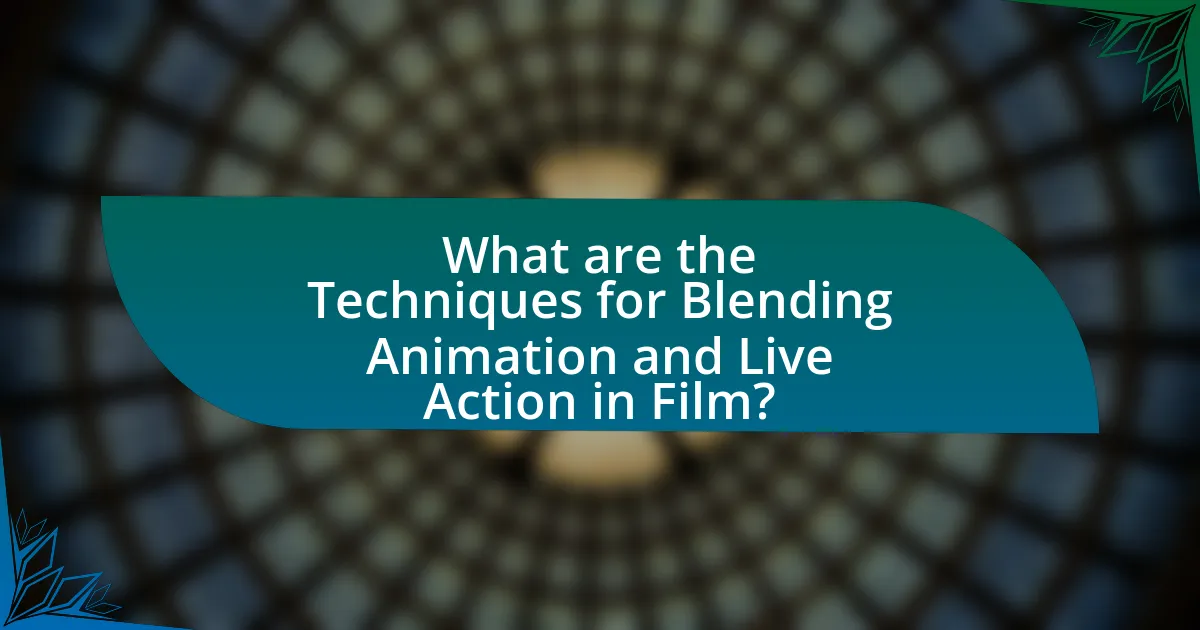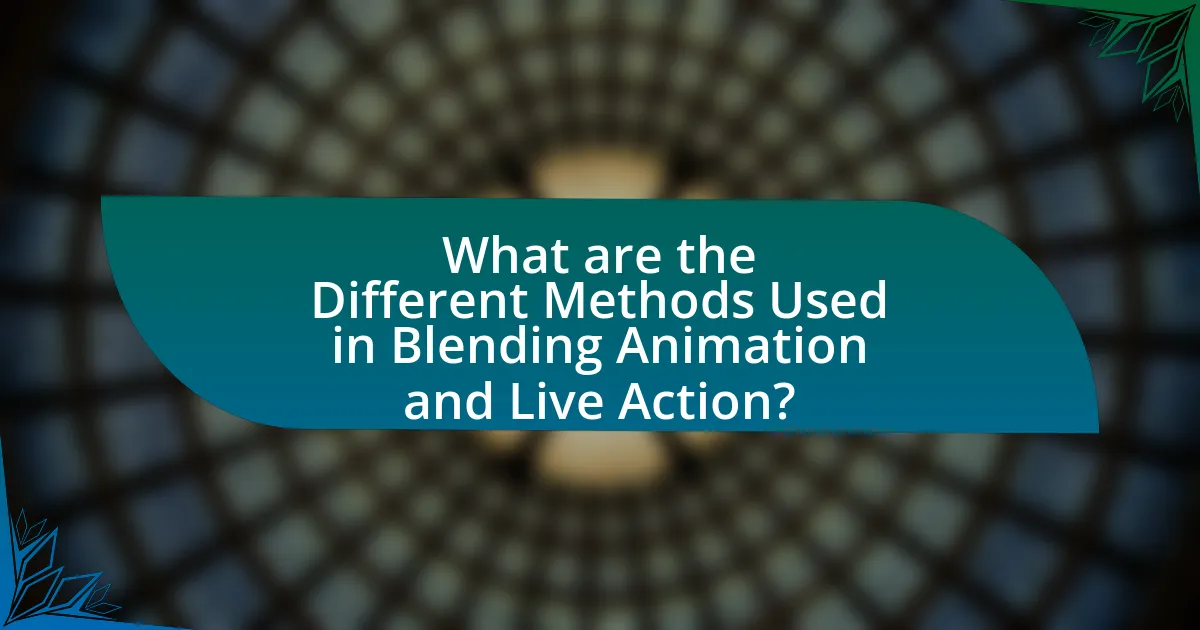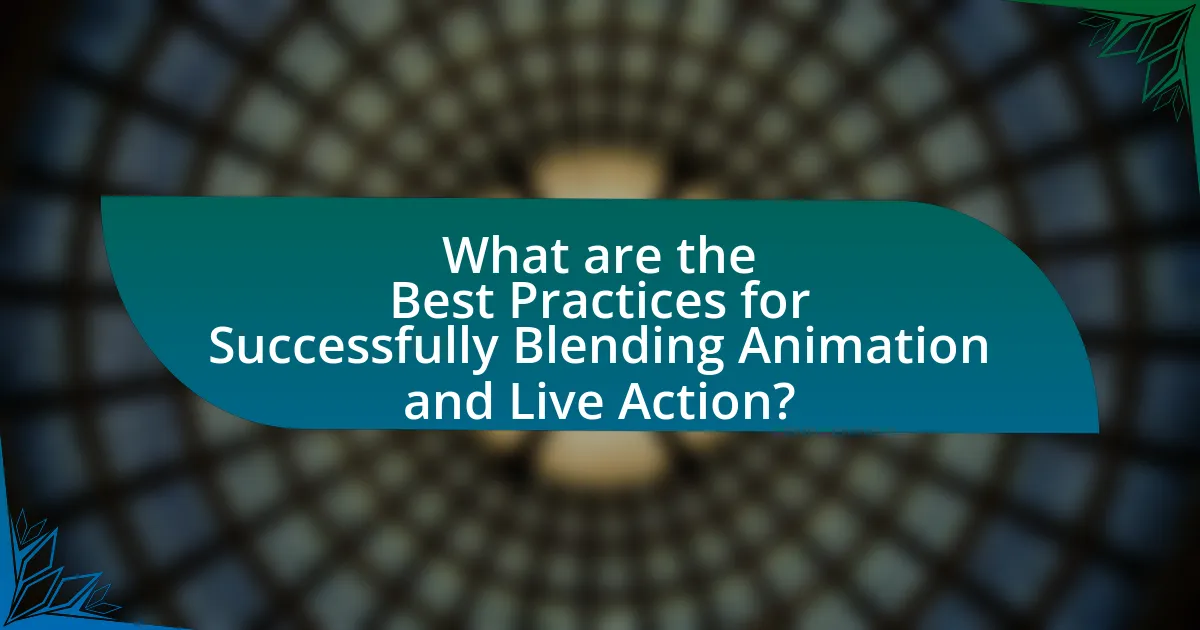The article focuses on the techniques for blending animation and live action in film, highlighting methods such as compositing, motion capture, rotoscoping, and green screens. It explores how these techniques enhance storytelling by creating immersive visual experiences and facilitating character development. The historical evolution of these methods is discussed, along with the impact of technological advancements like CGI. Additionally, the article outlines best practices for achieving seamless integration, common pitfalls to avoid, and tips for improving blending techniques, emphasizing the importance of consistent lighting, color palettes, and sound design in creating a cohesive viewing experience.

What are the Techniques for Blending Animation and Live Action in Film?
Techniques for blending animation and live action in film include compositing, motion capture, rotoscoping, and the use of green screens. Compositing involves layering animated elements over live-action footage, allowing for seamless integration. Motion capture records the movements of live actors to create realistic animated characters, as seen in films like “Avatar.” Rotoscoping involves tracing over live-action footage frame by frame to create animated sequences, which has been used in classics like “A Scanner Darkly.” Green screens enable filmmakers to replace backgrounds with animated environments, enhancing the visual storytelling. These techniques have been validated through their successful application in numerous films, demonstrating their effectiveness in creating engaging hybrid visuals.
How do these techniques enhance storytelling in film?
Techniques for blending animation and live action enhance storytelling in film by creating immersive visual experiences that engage audiences on multiple levels. These techniques allow filmmakers to seamlessly integrate animated elements with live-action footage, thereby expanding the narrative possibilities and visual creativity. For instance, films like “Who Framed Roger Rabbit” and “Space Jam” effectively use this blend to develop unique characters and fantastical worlds that would be impossible to portray through live action alone. This combination not only captivates viewers but also deepens emotional connections to the story, as audiences can relate to both animated and real characters in a shared environment.
What role does animation play in character development?
Animation plays a crucial role in character development by visually expressing emotions, personality traits, and narrative arcs that may be difficult to convey through live action alone. Through techniques such as exaggerated movements, facial expressions, and stylized designs, animation allows for a deeper exploration of a character’s inner world, making them more relatable and engaging to the audience. For instance, animated films like “Inside Out” utilize character design and movement to represent complex emotions, effectively illustrating how animation can enhance character depth and audience connection.
How does live action contribute to the emotional impact of animated elements?
Live action enhances the emotional impact of animated elements by providing a relatable human context that viewers can connect with. When live action characters interact with animated features, it creates a juxtaposition that emphasizes the fantastical aspects of animation while grounding the narrative in reality. This combination allows audiences to experience a deeper emotional resonance, as they can empathize with the live action characters’ feelings and reactions to the animated elements. For instance, films like “Who Framed Roger Rabbit” effectively use this technique, where the emotional stakes are heightened through the interactions between live actors and animated characters, making the overall experience more engaging and impactful.
What are the historical developments in blending animation and live action?
The historical developments in blending animation and live action began in the early 20th century with films like “Gertie the Dinosaur” (1914) by Winsor McCay, which showcased the potential of integrating animated characters with live-action footage. This technique evolved significantly with the advent of special effects technology, exemplified by “The Wizard of Oz” (1939), where animated elements were combined with live performances to create a fantastical narrative. The introduction of rotoscoping in the 1910s allowed animators to trace over live-action footage, enhancing realism in animated sequences. In the 1990s, films like “Who Framed Roger Rabbit” (1988) further advanced this integration by seamlessly combining animated characters with live actors in a shared environment, setting a new standard for the genre. The development of CGI in the late 20th century, as seen in “Jurassic Park” (1993), revolutionized the blending of animation and live action, allowing for more complex interactions and lifelike animations. These historical milestones illustrate the continuous innovation in techniques for merging animation with live action in film.
How have technological advancements influenced these techniques?
Technological advancements have significantly enhanced the techniques for blending animation and live action in film by providing tools that improve visual integration and realism. Innovations such as motion capture technology allow filmmakers to accurately translate an actor’s movements into animated characters, resulting in seamless interactions between live actors and animated elements. For instance, films like “Avatar” utilized advanced motion capture to create lifelike animated characters that convincingly interacted with human performers, demonstrating the effectiveness of these technologies. Additionally, developments in CGI (computer-generated imagery) have enabled the creation of highly detailed and realistic animated environments that can be integrated with live-action footage, as seen in “The Jungle Book,” where virtual environments were combined with live performances to create a cohesive visual narrative. These advancements have fundamentally transformed the filmmaking process, allowing for greater creative expression and storytelling possibilities.
What are some landmark films that pioneered this blending?
Some landmark films that pioneered the blending of animation and live action include “Who Framed Roger Rabbit” (1988), “Mary Poppins” (1964), and “Space Jam” (1996). “Who Framed Roger Rabbit” is notable for its innovative integration of animated characters with live-action footage, setting a new standard for the genre. “Mary Poppins” utilized a combination of live action and animated sequences, particularly in the iconic “Supercalifragilisticexpialidocious” scene, showcasing seamless interaction between characters. “Space Jam” further advanced this technique by combining live-action basketball with animated characters from the Looney Tunes franchise, demonstrating the commercial viability and creative potential of this blending technique.

What are the Different Methods Used in Blending Animation and Live Action?
The different methods used in blending animation and live action include compositing, rotoscoping, motion capture, and CGI integration. Compositing involves layering animated elements over live-action footage, allowing for seamless integration of both mediums. Rotoscoping is a technique where animators trace over live-action footage frame by frame to create realistic animations that match the movement of actors. Motion capture records the movements of actors and translates them into animated characters, ensuring lifelike motion. CGI integration combines computer-generated imagery with live-action scenes, enhancing visual storytelling by adding animated elements that interact with real-world environments. These methods have been utilized in various films, such as “Who Framed Roger Rabbit,” which effectively combined live action and animation through innovative compositing techniques.
How does rotoscoping work in this context?
Rotoscoping in the context of blending animation and live action in film involves tracing over live-action footage frame by frame to create realistic animations that integrate seamlessly with the filmed content. This technique allows animators to capture the nuances of human movement and expression, ensuring that animated characters interact believably with live-action elements. Historically, rotoscoping was pioneered by Max Fleischer in the early 20th century, and it has been utilized in various films, such as “Who Framed Roger Rabbit,” where animated characters were integrated into live-action scenes, demonstrating the effectiveness of this technique in achieving a cohesive visual narrative.
What are the advantages and disadvantages of using rotoscoping?
Rotoscoping offers the advantage of creating highly realistic animations by tracing over live-action footage, which allows for seamless integration of animated elements with real-world scenes. This technique has been used effectively in films like “A Scanner Darkly,” where it enhanced the visual storytelling by maintaining the nuances of human movement. However, the disadvantages include the time-consuming nature of the process, as it requires meticulous frame-by-frame work, and the potential for a lack of artistic spontaneity, as the rigid adherence to live-action footage can stifle creative expression. Additionally, rotoscoping can be costly due to the labor-intensive requirements, making it less accessible for smaller productions.
How does rotoscoping compare to other techniques?
Rotoscoping is a technique that involves tracing over live-action footage to create realistic animations, distinguishing it from other methods like traditional hand-drawn animation or CGI, which do not rely on existing footage. Unlike traditional animation, which requires artists to create each frame from scratch, rotoscoping allows for a more fluid and lifelike representation of movement, as seen in films like “A Scanner Darkly,” where the technique was used extensively to blend animated elements with live action. Additionally, CGI can create entirely new environments and characters but lacks the direct connection to real-world motion that rotoscoping provides, making it particularly effective for achieving a specific visual style that mimics reality.
What is the role of CGI in blending animation and live action?
CGI plays a crucial role in blending animation and live action by creating seamless visual effects that integrate animated elements into real-world footage. This technology allows filmmakers to combine live-action performances with computer-generated imagery, enhancing storytelling by adding fantastical elements that would be impossible to capture on camera alone. For instance, films like “Avatar” and “The Jungle Book” utilize CGI to create lifelike characters and environments that interact naturally with live actors, demonstrating the effectiveness of CGI in achieving a cohesive visual narrative.
How does CGI enhance the visual integration of animated elements?
CGI enhances the visual integration of animated elements by allowing for seamless interaction between live-action footage and computer-generated imagery. This technology enables animators to create realistic textures, lighting, and shadows that match the live-action environment, resulting in a cohesive visual experience. For instance, films like “Avatar” and “The Jungle Book” utilize advanced CGI techniques to blend animated characters with real-world settings, demonstrating how CGI can create believable interactions and enhance storytelling. The use of motion capture technology further supports this integration by translating the movements of live actors into animated characters, ensuring that their actions appear natural and fluid within the scene.
What are the challenges associated with using CGI in live action films?
The challenges associated with using CGI in live action films include issues with realism, integration, and cost. Realism is a significant challenge, as CGI must convincingly mimic real-world physics and textures to avoid breaking immersion; for instance, poorly rendered CGI can lead to a noticeable disconnect between live action and animated elements. Integration poses another challenge, as filmmakers must ensure that CGI elements interact seamlessly with live action footage, which requires precise lighting, shadows, and camera movements to match the physical environment. Additionally, the cost of high-quality CGI can be prohibitive, with budgets for major films often exceeding millions of dollars, making it a financial risk for studios. These challenges highlight the complexities involved in effectively blending CGI with live action to create a cohesive viewing experience.

What are the Best Practices for Successfully Blending Animation and Live Action?
The best practices for successfully blending animation and live action include maintaining consistent lighting and shadows, ensuring seamless integration of animated elements with live action, and using motion tracking for accurate placement. Consistent lighting and shadows help create a believable environment where animated characters or objects appear naturally within the scene. For instance, films like “Who Framed Roger Rabbit” effectively used these techniques to create a cohesive visual experience. Motion tracking technology allows animators to align animated elements with the movements of live actors, enhancing realism. These practices are essential for achieving a harmonious blend that engages audiences and maintains immersion.
How can filmmakers ensure a seamless integration of both elements?
Filmmakers can ensure a seamless integration of animation and live action by employing techniques such as careful planning of visual effects, consistent lighting, and matching camera angles. These methods create a cohesive visual experience that allows both elements to interact naturally. For instance, using motion tracking technology enables animators to align animated elements with live-action footage accurately, ensuring that movements appear synchronized. Additionally, maintaining a consistent color palette and lighting conditions across both mediums enhances the believability of the scene, as evidenced by films like “Who Framed Roger Rabbit,” which successfully blended animation with live action through meticulous attention to these details.
What techniques can be used to match lighting and shadows?
Techniques to match lighting and shadows include color grading, light matching, and shadow casting. Color grading adjusts the overall tone and color of the footage to ensure consistency between animated and live-action elements. Light matching involves analyzing the direction, intensity, and color of light in the live-action scene and replicating these conditions in the animated components. Shadow casting is crucial; it requires creating shadows in the animation that mimic the shadows present in the live-action footage, ensuring that both elements interact realistically. These techniques are essential for achieving a seamless blend between animation and live action, enhancing visual coherence and immersion.
How important is the choice of color palette in blending?
The choice of color palette is crucial in blending animation and live action in film. A well-selected color palette ensures visual harmony between animated elements and live-action footage, enhancing the overall aesthetic and narrative coherence. For instance, films like “Who Framed Roger Rabbit” effectively utilized a consistent color scheme to integrate animated characters seamlessly into real-world settings, demonstrating that a cohesive color palette can significantly impact viewer perception and immersion.
What common pitfalls should filmmakers avoid?
Filmmakers should avoid poor planning, which can lead to disjointed storytelling and ineffective integration of animation and live action. Insufficient pre-production work often results in mismatched visual styles and pacing issues, undermining the overall coherence of the film. For instance, a study by the American Film Institute highlights that films with detailed storyboards and animatics tend to have smoother transitions between animation and live action, enhancing audience engagement. Additionally, neglecting sound design can detract from the immersive experience, as sound plays a crucial role in blending these two mediums effectively.
How can over-reliance on animation detract from the story?
Over-reliance on animation can detract from the story by overshadowing character development and emotional depth. When animation dominates, it may prioritize visual spectacle over narrative substance, leading to a disconnection between the audience and the characters. For instance, films like “The Lego Movie” showcase vibrant animation but risk superficial storytelling if character arcs are not adequately explored. This imbalance can result in a lack of audience engagement, as viewers may become more focused on the animation techniques rather than the underlying themes and messages of the story.
What are the risks of inconsistent visual styles?
Inconsistent visual styles can lead to viewer confusion and disengagement. When animation and live action are not cohesively integrated, audiences may struggle to understand the narrative or emotional tone, resulting in a disjointed viewing experience. Research indicates that visual coherence enhances audience immersion; for instance, a study published in the Journal of Media Psychology found that consistent visual styles significantly improve viewer comprehension and emotional connection. Therefore, the lack of a unified visual approach can undermine the effectiveness of storytelling in film.
What tips can help filmmakers improve their blending techniques?
Filmmakers can improve their blending techniques by focusing on consistent lighting and color grading across both animation and live-action elements. Consistent lighting ensures that animated components match the shadows and highlights of the live-action footage, creating a seamless integration. Additionally, color grading helps unify the visual tone, making the animation appear as a natural part of the scene. Research indicates that films employing these techniques, such as “Who Framed Roger Rabbit,” achieved a more immersive experience by effectively blending animated characters with real environments.


